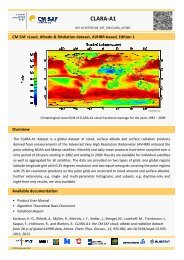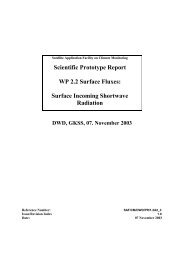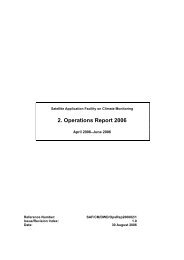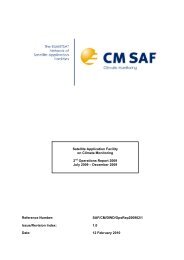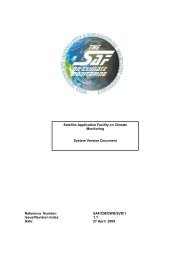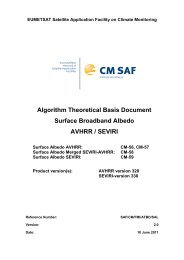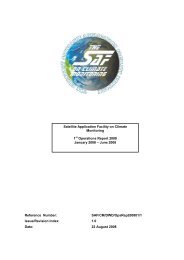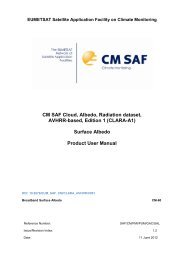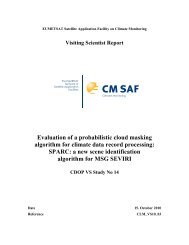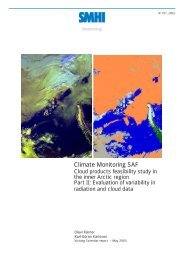Aerosol retrievals from METEOSAT-8 - CM SAF
Aerosol retrievals from METEOSAT-8 - CM SAF
Aerosol retrievals from METEOSAT-8 - CM SAF
You also want an ePaper? Increase the reach of your titles
YUMPU automatically turns print PDFs into web optimized ePapers that Google loves.
<strong>SAF</strong> on Climate Monitoring Visiting Scientists Report Doc. No: 1.0<br />
Issue : 1.0<br />
Date : 4 October 2006<br />
5.1.1 Algorithms using angular information<br />
The POLDER aerosol retrieval over land is based on a Bidirectional Reflectance Distribution<br />
Function (BRDF) model deduced <strong>from</strong> polarized and multidirectional radiances measurements in<br />
the red and the NIR channels. This model has empirical coefficients adjusted for different classes of<br />
land surfaces (Deuzé et al. 2001). Because of the geometry dependence of the surface reflectance,<br />
multidirectional measurements are a promising method for the aerosol property <strong>retrievals</strong> over land.<br />
Veefkind et al. (2000) developed a method based on the dual-view image radiometer of the Along<br />
Tracking Scanning Radiometer 2 (ATSR-2). The method is based on the wavelength-independent<br />
ratio between forward and nadir view surface reflection that depends only on the sun/satellite<br />
geometry. The value of the ratio is first estimated in the Mid-IR channel of ATSR-2 where the<br />
atmospheric contribution is neglected. It can be combined with another sensor with high spectral<br />
resolution to obtain information about the aerosol model to use. For example an algorithm<br />
combining AASTR and SCHIAMACHY aboard ENVISAT or ATSR-2 and GOME aboard ERS-2<br />
has been developed and provides AOT and aerosol types (Holzer-Popp et al. 2002). Another<br />
multidirectional measurements algorithm has been developed for MISR. The algorithm uses the<br />
presence of spatial contrast to derive empirical function representation of the angular variation of<br />
the scene reflectance, which is then used to estimate the path radiance (Martonchik et al. 1998).<br />
Figure 1 and 2 present examples of AASTR/SCHIAMACHY and POLDER-3/PARASOL<br />
<strong>retrievals</strong>, respectively.<br />
5.1.2 Algorithms using spectral indices<br />
MODIS uses a classical approach to predict the surface reflectance, which relates the TOA<br />
radiances in the IR at 2.13 µm to the visible surface reflectance in the blue (0.47 µm) and in the red<br />
(0.66 µm). <strong>Aerosol</strong> retrieval (spectral optical thickness in two channels) is performed for targets as<br />
bright as 0.25 in reflectance unit in the IR and an average is performed in a 20x20 box after<br />
rejecting some outliers, thus resulting in a 10x10km spatial resolution for the aerosol product<br />
(Kaufman and Tanré, 1998). After intensive validation with AERONET data, Remer et al. (2005)<br />
show that the AOTs accuracy is within ∆τ = ±0.05 ±0.15τ. The surface coverage is good as can be<br />
seen in Fig. 3. This product is available twice a day (Terra, ~10:30 p.m. and Aqua, ~1:30 p.m.).<br />
MERIS aerosol property <strong>retrievals</strong> over land are based on the use of pixels covered by vegetation.<br />
Dense Dark Vegetation pixels are selected using the Atmospheric Resistant Vegetation Index<br />
(ARVI) as spectral index, which uses Rayleigh corrected reflectances at 443, 670 and 865 nm.<br />
- 10 -



